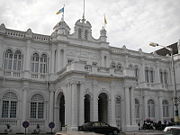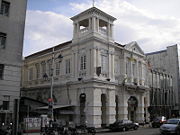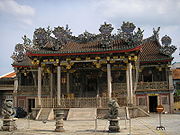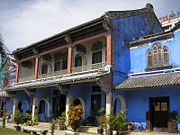
Architecture of Penang
Encyclopedia








Chinese architecture
Chinese architecture refers to a style of architecture that has taken shape in East Asia over many centuries. The structural principles of Chinese architecture have remained largely unchanged, the main changes being only the decorative details...
, Indian
Indian architecture
The architecture of India is rooted in its history, culture and religion. Indian architecture progressed with time and assimilated the many influences that came as a result of India's global discourse with other regions of the world throughout its millennia-old past...
, Islamic
Islamic architecture
Islamic architecture encompasses a wide range of both secular and religious styles from the foundation of Islam to the present day, influencing the design and construction of buildings and structures in Islamic culture....
and other elements to create a unique and distinctive brand of architecture. Along with Malacca
Malacca
Malacca , dubbed The Historic State or Negeri Bersejarah among locals) is the third smallest Malaysian state, after Perlis and Penang. It is located in the southern region of the Malay Peninsula, on the Straits of Malacca. It borders Negeri Sembilan to the north and the state of Johor to the south...
, Penang is an architectural gem of Malaysia and Southeast Asia
Southeast Asia
Southeast Asia, South-East Asia, South East Asia or Southeastern Asia is a subregion of Asia, consisting of the countries that are geographically south of China, east of India, west of New Guinea and north of Australia. The region lies on the intersection of geological plates, with heavy seismic...
. Unlike Singapore
Singapore
Singapore , officially the Republic of Singapore, is a Southeast Asian city-state off the southern tip of the Malay Peninsula, north of the equator. An island country made up of 63 islands, it is separated from Malaysia by the Straits of Johor to its north and from Indonesia's Riau Islands by the...
, also a Straits Settlement, where many heritage buildings had to make way for modern skyscrapers and high-rise apartments due to rapid development and acute land scarcity, Penang's architectural heritage has enjoyed a better fate. Penang has one of the largest collections of pre-war buildings in Southeast Asia. This is for the most part due to the Rent Control Act which froze house rental prices for decades, making redevelopment unprofitable. With the repeal of this act in 2000 however, property prices skyrocketed and development has begun to encroach upon these buildings, many of which are in a regrettable state of disrepair. The government in recent years has allocated more funding to finance the restoration of a number of derelict heritage buildings, most notably Suffolk House
Suffolk House, Penang
In Penang, Malaysia, the Suffolk House refers to two early residences built on the same site located some four miles west of George Town, Penang, on the banks of the Air Itam River...
, City Hall
City Hall, Penang
City Hall is a municipal building in George Town, Penang, which was formerly the seat of the City Council of George Town.Originally built in 1903 as the Municipal Office, Penang, the building was erected at a cost of $100,000 to relieve demand for office space at the adjacent Town Hall, which then...
and historic buildings in the old commercial district.
Colonial style
Fort CornwallisFort Cornwallis
Fort Cornwallis is an old star-shaped fort located on the northeastern coast of Penang, Malaysia. It is named after the late 18th century Governor-General of Bengal, India, Charles Cornwallis, 1st Marquess Cornwallis...
, built by Francis Light
Francis Light
Captain Francis Light was the founder of the British colony of Penang and its capital George Town in 1786.-Early years:...
as a defensive measure when he first gained possession of Penang island, is the oldest British structure in Penang. Located where the Esplanade now stands and where he first landed on the island, it was originally built of wood and was subsequently replaced by brick.
The architecture of the Suffolk House is of the Anglo-Indian
Anglo-Indian
Anglo-Indians are people who have mixed Indian and British ancestry, or people of British descent born or living in India, now mainly historical in the latter sense. British residents in India used the term "Eurasians" for people of mixed European and Indian descent...
Garden House style, commonly found in British India
British Raj
British Raj was the British rule in the Indian subcontinent between 1858 and 1947; The term can also refer to the period of dominion...
. It sits upon land once owned by Light as his pepper estate whereupon light built a humble timber and attap
Nypa fruticans
Nypa fruticans, known as the attap palm , nipa palm , and mangrove palm or buah atap , buah nipah , dừa nước , Ging Pol in Sinhala in Sri Lanka and gol pata , dani . It is the only palm considered a mangrove in the Mangroves Biome...
garden house, noted in letters from visiting friends. The current colonnaded Euro-Indian Georgian building was thought to have been built by W. E. Phillips following his purchase of the land from Light's former partner Scott. Nestled on the bank of the Ayer Itam River, the building was used by Governor Bannerman—Phillip's father-in-law—amongst other Governors of Penang and also the Governors of the Straits Settlements. It was occupied by the Imperial Japanese
Empire of Japan
The Empire of Japan is the name of the state of Japan that existed from the Meiji Restoration on 3 January 1868 to the enactment of the post-World War II Constitution of...
administration during the Second World War
World War II
World War II, or the Second World War , was a global conflict lasting from 1939 to 1945, involving most of the world's nations—including all of the great powers—eventually forming two opposing military alliances: the Allies and the Axis...
. Later, it was utilised by the Methodist Boys' School
Methodist Boys' School (Penang)
Methodist Boys' School, Penang is a secondary school for boys in Penang, Malaysia. It was established in 1891 by Methodist missionary Reverend Balderstone.-Beginning:...
which was built next to the house. Today, having weathered years of neglect, it is being meticulously restored with the help of researchers from the United Kingdom, Malaysia and Australia.
Other distinguished buildings from the colonial period include the City Hall
City Hall, Penang
City Hall is a municipal building in George Town, Penang, which was formerly the seat of the City Council of George Town.Originally built in 1903 as the Municipal Office, Penang, the building was erected at a cost of $100,000 to relieve demand for office space at the adjacent Town Hall, which then...
, the Town Hall, the Eastern and Oriental Hotel
Eastern & Oriental Hotel
The Eastern & Oriental Hotel is a colonial-style hotel in Penang that was established in 1885 by the Armenian Sarkies Brothers. The sea-fronting hotel is known for its luxurious accommodation and restaurants. The address is at 10 Lebuh Farquhar.The Eastern Hotel was founded by the brothers in 1884...
(Penang's first grand hotel), the Mansion, the Garage, the Standard Chartered Bank building, the HSBC
HSBC
HSBC Holdings plc is a global banking and financial services company headquartered in Canary Wharf, London, United Kingdom. it is the world's second-largest banking and financial services group and second-largest public company according to a composite measure by Forbes magazine...
building, the Southern Bank
Southern Bank
Southern Bank was a Malaysian bank and the ninth-largest lender while being one of the ten anchor banks in Malaysia.In 2006 it was bought over by Bumiputra-Commerce Holdings . BCHB plans to delist the bank from public listing as well as Bumiputra-Commerce and CIMB...
building, the Uplands International School
Uplands International School of Penang
The International School Of Penang , commonly known as Uplands School or simply Uplands by its members , is an international school in Penang, Malaysia...
building, as well as the great trading houses of Weld Quay. Many of these render the eclectic architectural styles of the Victorian
Victorian architecture
The term Victorian architecture refers collectively to several architectural styles employed predominantly during the middle and late 19th century. The period that it indicates may slightly overlap the actual reign, 20 June 1837 – 22 January 1901, of Queen Victoria. This represents the British and...
and Georgian
Georgian architecture
Georgian architecture is the name given in most English-speaking countries to the set of architectural styles current between 1720 and 1840. It is eponymous for the first four British monarchs of the House of Hanover—George I of Great Britain, George II of Great Britain, George III of the United...
eras as well as Art Deco
Art Deco
Art deco , or deco, is an eclectic artistic and design style that began in Paris in the 1920s and flourished internationally throughout the 1930s, into the World War II era. The style influenced all areas of design, including architecture and interior design, industrial design, fashion and...
and Anglo-Indian.
Chinese influence
Chinese immigrants brought with them architecture from their ancestral land as can be seen in the many Chinese templeTemple
A temple is a structure reserved for religious or spiritual activities, such as prayer and sacrifice, or analogous rites. A templum constituted a sacred precinct as defined by a priest, or augur. It has the same root as the word "template," a plan in preparation of the building that was marked out...
s and clan
Clan
A clan is a group of people united by actual or perceived kinship and descent. Even if lineage details are unknown, clan members may be organized around a founding member or apical ancestor. The kinship-based bonds may be symbolical, whereby the clan shares a "stipulated" common ancestor that is a...
houses. Examples that stand out include the Cheong Fatt Tze Mansion
Cheong Fatt Tze Mansion
Cheong Fatt Tze Mansion is located at 14 Leith Street, 10200 George Town, Penang, Malaysia. The mansion's indigo-blue outer wall makes it a very distinct building in the area....
(also known as the Blue Mansion), built by the namesake Qing-dynasty Chinese immigrant who was a hugely successful trader and community leader; the Kuan Yin Temple
Kong Hock Keong Temple
Kong Hock Keong Temple is a Taoist temple in Georgetown, Penang in north-west Malaysia. It is dedicated to the worship of Guanyin. It is located on Jalan Kapitan Keling....
, the Khoo Kongsi
Khoo Kongsi
The Khoo Kongsi is a large Chinese clanhouse with elaborate and highly ornamented architecture, a mark of the dominant presence of the Chinese in Penang, Malaysia. The famous Khoo Kongsi is the grandest clan temple in the country. It is also one of the city's major historic attraction...
, and the intricate clan house of the influential Khoo clan. The spectacular temple of Kek Lok Si
Kek Lok Si
The Kek Lok Si Temple is a Buddhist temple situated in Air Itam in Penang and is one of the best known temples on the island. It is the largest Buddhist temple in Southeast Asia....
at the foothill of Penang Hill is the largest Buddhist temple in Southeast Asia. Known as the Temple of Ten Thousand Buddhas, it was largely built by artisans and worksmen from China in the 19th century. A great many of the shophouses and residences found in George Town were built in the style of Straits-Chinese architecture with their very recognisable red terracotta roofs.
Nouveau riche
Nouveau riche
The nouveau riche , or new money, comprise those who have acquired considerable wealth within their own generation...
Chinese millionaires of the time built themselves stately mansions along the famed Millionaires' Row of Northam Road (now Sultan Ahmad Shah Road). One of the most famous of them still standing today is the Yeap mansion, resplendent in white. The holiday palace of the Sultan of Kedah
Kedah
Kedah is a state of Malaysia, located in the northwestern part of Peninsular Malaysia. The state covers a total area of over 9,000 km², and it consists of the mainland and Langkawi. The mainland has a relatively flat terrain, which is used to grow rice...
, Istana Kedah is also located on the same stretch.

